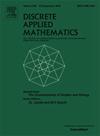半完全多部有向图中的广义路径和环
IF 1
3区 数学
Q3 MATHEMATICS, APPLIED
引用次数: 0
摘要
有向图是半完备的,如果它没有一对非相邻的顶点。如果每一对不同的顶点都诱导出一个2环,则它是完备的。如果可以从半完全有向图D中选择V(D)的顶点不相交子集X1,…,Xc的集合,然后删除所有端点都位于某个Xi内的弧,则该有向图就是半完全多部图。我们也可以把半完全有向图看作是由相同顶点集和部集V1,…,Vc上的半完全多部有向图对每个部集Vi的半完全有向图Di在Vi上的弧相加而得到的。众所周知,对于半完全多部有向图,哈密顿路径和哈密顿循环问题都可以在多项式时间内求解。本文研究了在由半完全多部有向图D和半完全有向图Di=(Vi,Ai), i∈[c]得到的半完全有向图S中寻找哈密顿路径或环的复杂性,使得该路径或环使用尽可能少的A1∪…Ac的弧。当每个Di都是完全有向图时,我们得到了一些结果。这种情况在循环情况下是非常重要的,复杂性仍然是开放的。我们展示了如何在多项式时间内找到一个使用尽可能少的Di弧线的哈密顿路径,并在哈密顿循环上获得了一些结果,包括结构和算法上的结果,这些结果使用了最小或接近最小数量的Di弧线。我们的结果暗示了np完全{0,1}-TSP问题的一些特殊情况的多项式可解性。最后,我们证明了关于半完全多部有向图中满足所有部集的环的性质的两个自然问题是np完全的。本文章由计算机程序翻译,如有差异,请以英文原文为准。
Generalized paths and cycles in semicomplete multipartite digraphs
A digraph is semicomplete if it has no pair of non-adjacent vertices. It is complete if every pair of distinct vertices induces a 2-cycle. A digraph is semicomplete multipartite if it can be obtained from a semicomplete digraph by choosing a collection of vertex-disjoint subsets of and then deleting all arcs both of whose end-vertices lie inside some . We can also think of a semicomplete digraph as being obtained from a semicomplete multipartite digraph on the same vertex set and partite sets by adding the arcs of a semicomplete digraph on for each partite set . It is well known that both the hamiltonian path and the hamiltonian cycle problem can be solved in polynomial time for semicomplete multipartite digraphs. In this paper we study the complexity of finding a hamiltonian path or cycle in a semicomplete digraph which is obtained as above from a semicomplete multipartite digraph and semicomplete digraphs , such that the path or cycle uses as few arcs of as possible. We obtain a number of results for the case when each is a complete digraph. Already this case is highly nontrivial in the cycle case and the complexity is still open. We show how to find a Hamiltonian path which uses as few arcs from the ’s as possible in polynomial time and obtain a number of results, both structural and algorithmic on hamiltonian cycles that use the minimum or close to the minimum number of arcs from the ’s. Our results imply the polynomial solvability of some special cases of the NP-complete -TSP problem. Finally we show that two natural questions about properties of quasi-hamiltonian cycles, that is, cycles meeting all partite sets in semicomplete multipartite digraphs are NP-complete.
求助全文
通过发布文献求助,成功后即可免费获取论文全文。
去求助
来源期刊

Discrete Applied Mathematics
数学-应用数学
CiteScore
2.30
自引率
9.10%
发文量
422
审稿时长
4.5 months
期刊介绍:
The aim of Discrete Applied Mathematics is to bring together research papers in different areas of algorithmic and applicable discrete mathematics as well as applications of combinatorial mathematics to informatics and various areas of science and technology. Contributions presented to the journal can be research papers, short notes, surveys, and possibly research problems. The "Communications" section will be devoted to the fastest possible publication of recent research results that are checked and recommended for publication by a member of the Editorial Board. The journal will also publish a limited number of book announcements as well as proceedings of conferences. These proceedings will be fully refereed and adhere to the normal standards of the journal.
Potential authors are advised to view the journal and the open calls-for-papers of special issues before submitting their manuscripts. Only high-quality, original work that is within the scope of the journal or the targeted special issue will be considered.
 求助内容:
求助内容: 应助结果提醒方式:
应助结果提醒方式:


